Author: Nina Louise PurvisMedical student, Queen Mary University of London; Postgraduate Researcher, King’s College London 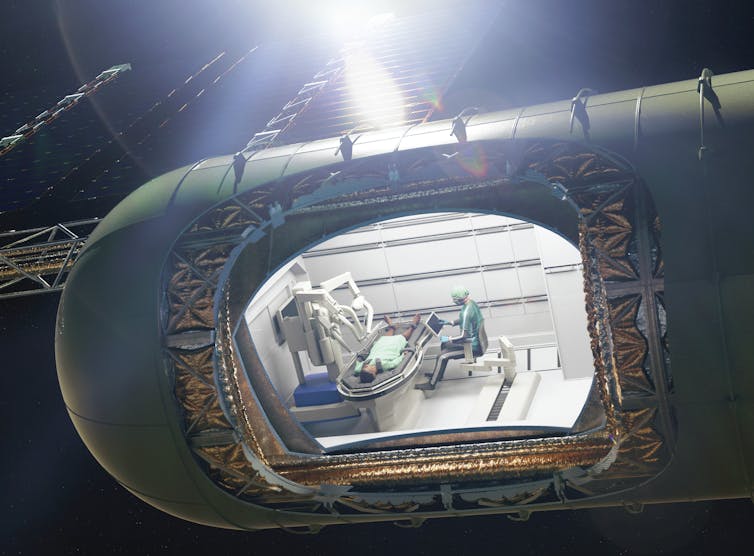
Earlier this year, it was reported that an astronaut in space had developed a potentially life-threatening blood clot in the neck. This was successfully treated with medication by doctors on Earth, avoiding surgery. But given that space agencies and private spaceflight companies have committed to landing humans on Mars in the coming decades, we may not be so lucky next time. Surgical emergencies are in fact one of the main challenges when it comes to human space travel. But over the last few years, space medicine researchers have come up with a number of ideas that could help, from surgical robots to 3D printers. Mars is a whopping 54.6 million kilometres (33.9 million miles) away from Earth, when closest. In comparison, the International Space Agency (ISS) orbits just 400 kilometres above Earth. For surgical emergencies on the ISS, the procedure is to stabilise the patient and transport them back to Earth, aided by telecommunication in real time. This won’t work on Mars missions, where evacuation would take months or years, and there may be a latency in communications of over twenty minutes. As well as distance, the extreme environment faced during transit to and on Mars includes microgravity, high radiation levels and an enclosed pressurised cabin or suit. This is tough on astronauts’ bodies and takes time getting used to. We already know that space travel changes astronauts’ cells, blood pressure regulation and heart performance. It also affects the body’s fluid distribution and weakens its bones and muscles. Space travellers may also more easily develop infections. So in terms of fitness for surgery, an injured or unwell astronaut will be already at a physiological disadvantage. 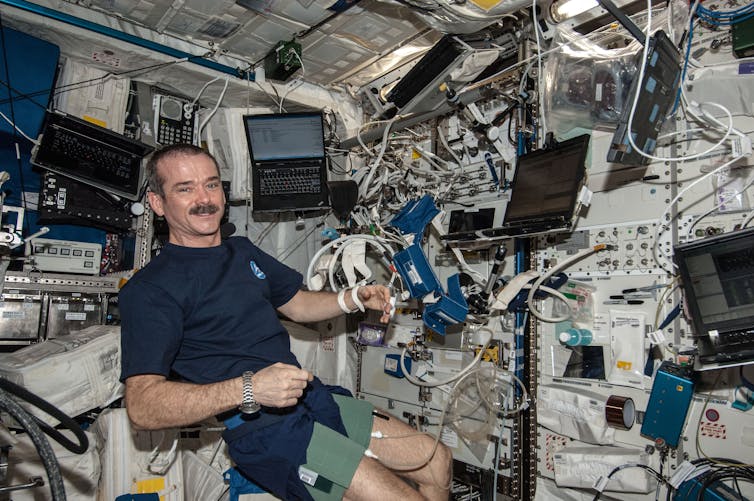
But how likely is it that an astronaut will actually need surgery? For a crew of seven people, researchers estimate that there will be an average of one surgical emergency every 2.4 years during a Mars mission. The main causes include injury, appendicitis, gallbladder inflammation or cancer. Astronauts are screened extensively when they are selected, but surgical emergencies can occur in healthy people and may be exacerbated in the extreme environment of space. Floating intestinesSurgery in microgravity is possible and has already been been carried out, albeit not on humans yet. For example, astronauts have managed to repair rat tails and perform laparoscopy – a minimally invasive surgical procedure used to examine and repair the organs inside the abdomen – on animals, while in microgravity. These surgeries have led to new innovations and improvements such as magnetising surgical tools so they stick to the table, and restraining the “surgeonaut” too. One problem was that, during open surgery, the intestines would float around, obscuring view of the surgical field. To deal with this, space travellers should opt for minimally invasive surgical techniques, such as keyhole surgery, ideally occurring within patients’ internal cavities through small incisions using a camera and instruments. A laparoscopy was recently carried out on fake abdomens during a parabolic “zero gravity” flight, with surgeons successfully stemming traumatic bleeding. But they warned that it would be psychologically hard to carry out such a procedure on a crew mate. Bodily fluids will also behave differently in space and on Mars. The blood in our veins may stick to instruments because of surface tension. Floating droplets may also form streams that could restrict the surgeon’s view, which is not ideal. The circulating air of an enclosed cabin may also be an infection risk. Surgical bubbles and blood-repelling surgical tools could be the solution. Researchers have already developed and tested various surgical enclosures in microgravity environments. For example, NASA evaluated a closed system comprising a surgical clear plastic overhead canopy with arm ports, aiming to prevent contamination. When orbiting or settled on Mars, however, we would ideally need a hypothetical “traumapod”, with radiation shielding, surgical robots, advanced life support and restraints. This would be a dedicated module with filtered air supply and a computer to aid in diagnosis and treatment. Robots and 3D printingThe surgeries carried out in space so far have revealed that a large amount of support equipment is essential. This is a luxury the crew may not have on a virgin voyage to Mars. You cannot take much equipment on a rocket. It has therefore been suggested that a 3D printer could use materials from Mars itself to develop surgical tools. Tools that have been 3D printed have been successfully tested by crew with no prior surgical experience, performing a task similar to surgery simply by cutting and suturing materials (rather than a body). There was no substantial difference in time to completion with 3D printed instruments such as towel clamps, scalpel handles and toothed forceps. 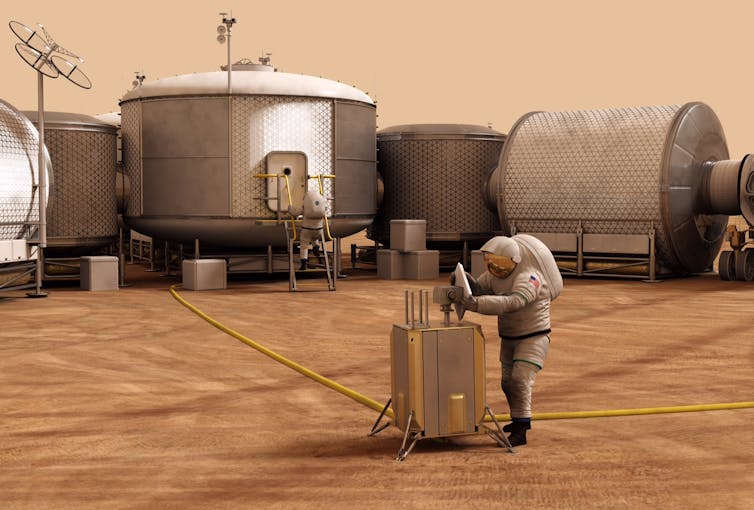
Robotic surgery is another option that has been used routinely on Earth, and tested for planetary excursions. During NEEMO 7, a series of missions in the underwater habitat Aquarius in Florida Keys by NASA, surgery by a robot controlled from another lab was successfully used to remove a fake gallbladder and kidney stone from a fake body. However, the lag in communications in space will make remote control a problem. Ideally, surgical robots would need to be autonomous. There is a wealth of research and preparation for the possible event of a surgical emergency during a Mars mission, but there are many unknowns, especially when it comes to diagnostics and anaesthesia. Ultimately, prevention is better than surgery. So selecting healthy crew and developing the engineering solutions needed to protect them will be crucial. This article is republished from The Conversation under a Creative Commons license. Read the original article. Rosemary S. A. Shinkai, DDS, MSc, PhD Professor of Dentistry, Pontifical Catholic University of Rio Grande do Sul, Brazil
We still do not know much about the changes in dental and orofacial structures, functions, and diseases beyond Earth. Early studies on aerospace dentistry published at the end of the 1960’s and 1970’s addressed some concerns about oral health in astronauts and challenges for dental treatment delivery in space. If astronauts are selected for being the most prepared and healthy humans to withstand the hard conditions in outer space, what about everyday regular people, the very young or old individuals? Or pregnant space voyagers? Microgravity and radiation in long-term spaceflights and a lifelong stay in space stations or settlements would require specific oral health care. Teeth, gums, tongue, bones, and muscles are part of a complex system, which is highly innervated and irrigated by blood vessels to allow chewing, swallowing, speaking, and smiling. Saliva is produced by a number of large and small salivary glands to lubricate the mouth, form the food bolus, and counterbalance acids produced by mouth bacteria after meals. Recent studies have shown that the microgravity and spaceflight environment alters jaw bone physiology, dental development, saliva proteins, and salivary gland morphology in mice flown on a US shuttle and a Russian biosatellite. Another study revealed that adult rats submitted to gravity tests showed remodeling of craniomandibular bones. Simulated microgravity also modified gene expression and physiology of Streptoccocus mutans and Streptoccocus sanguinis, possibly altering the cariogenic potential of these bacteria. However, the specific effect of space radiation also needs to be investigated. 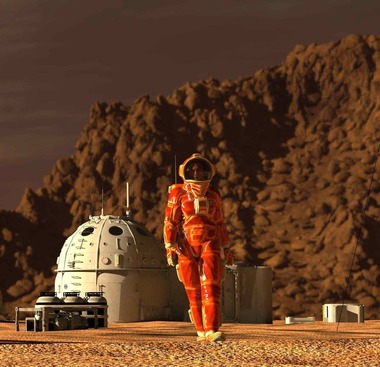 Will oral health care need adapting for long-term Mars settlement? Will oral health care need adapting for long-term Mars settlement? It still is unknown to what extent the same effect would occur in human astronauts. Besides the potential structural and physiological changes in the craniomandibular system, other behavioral factors and epigenetics are involved in space oral health. For example, dental caries result from a frequent exposure to acids produced by mouth bacteria after ingestion of sugar, mainly sticky or soft, paste-like foods. Thus, eating and cleaning habits modify the risk for dental caries. And the protective saliva flow and composition vary with water drinking, chewing stimulation, medication, and stress. All these factors may be altered in space life and would affect individual responses to not only dental caries risk, but also gum inflammation, orofacial pain, bone loss and repair. Understanding the underlying mechanisms to prevent oral health problems and have effective interventions seems to be appropriate for the planning of long-term space travel. So, space dentistry may be an interesting job in the future! Prof. K. Ganapathy InnovaSpace Advisory Board member, Past President Telemedicine Society of India, Former Secretary/Past President Neurological Society of India & Indian Society for Stereotactic & Functional Neurosurgery, Emeritus Professor Tamilnadu Dr MGR Medical University, Former Adjunct Professor IIT Madras & Anna University Madras, Founder Director, Apollo Telemedicine Networking Foundation & Apollo Tele Health.  Three decades ago even contemplating the subject of the human brain in space would have been considered preposterous. Two decades hence and Extra Terrestrial Neurosciences could become a distinct sub-speciality. With periods of stay in the International Space Station steadily increasing, manned missions to the Moon being revived, and even humans going to Mars being seriously planned, it is imperative we know what happens structurally and functionally to various parts of the human brain when it is exposed to microgravity and cosmic radiation for prolonged periods. This is no longer a theoretical academic discussion. For decades we have relied on experimental simulation studies on the brains of rats exposed to microgravity and cosmic radiation. Mice exposed for six months to the radiation levels prevalent in interplanetary space exhibited serious memory and learning impairments, also becoming more anxious and fearful. Structural changes at a microscopic level, including changes in neurotransmitters were demonstrated.  It is only in the last decade that reliable, prospective clinical and sophisticated imaging studies have been carried out on astronaut brains before and after exposure to real world conditions. The human brain was primarily designed for standing in gravity on Earth with almost no exposure to radiation. When we leave the Earth’s gravitational pull all bodily fluids move upward. The first evidence for structural changes in the brain after long-term spaceflight includes narrowing of the central sulcus, a shrinking of the cerebrospinal fluid (CSF) spaces at the vertex, and an upward shift of the brain. MRI scans before spaceflight, shortly after and several months after return to Earth revealed a significant increase in size of the lateral and third ventricles immediately post-flight and a trend towards normalization at follow-up. There was an upward shift of the brain after all long-duration flights. Significant volumetric gray matter decreases, including large areas in the temporal and frontal poles and around the orbits have been documented. This effect was more noticeable in crewmembers with prolonged stay in the International Space Station. Bilateral focal gray matter increases within the medial primary somatosensory and motor cortex (cerebral areas representing lower limbs) were noted. Cortical reorganization in an astronaut’s brain after long-duration spaceflight has now been confirmed. MRI documented structural changes raise the risk of possible impairment of behaviour, cognition and performance. This could compromise mission critical decisions. In 2017, a study revealed that long missions in space results in reduction of protective CSF surrounding brain volume at the top of astronauts’ brains. These changes underlie the astronauts’ performance on certain critical tasks, such as opening the space station’s hatch, climbing a ladder, exiting a vehicle or even walking along the surface of a planet. Follow up MRI scans have revealed that re-exposure to Earth’s gravity and lack of continuing exposure to unnatural radiation can generally reverse these space travel induced changes. Astronauts have to undergo extensive training before and during spaceflight to maintain muscle mass, and this can result in localised increased grey matter, particularly in the sensorimotor regions of the brain, representing the lower limbs. This is due to neuroplasticity or adaptation within the cerebrum and cerebellum. The most notable findings in the MRI’s were a post-flight increase in the stimulation-specific connectivity of the right posterior supra marginal gyrus with the rest of the brain; a strengthening of connections between the left and right insulae, decreased connectivity of the vestibular nuclei, right inferior parietal cortex and cerebellum with areas associated with motor, visual, vestibular, and proprioception functions. Study of permanent visual acuity impairments associated with spaceflight have demonstrated structural changes in the CSF around the optic nerves and the globe of the eyes.
Domain expertise in Extra Terrestrial Neurosciences will eventually be a reality. While the number of subjects studied may at the best be a few hundreds, the lessons learnt could make us relook at the traditional neurosciences we have been believing in for the last two centuries. Let us never forget that the future is always ahead of schedule !! Nelson A. Campos VinagreCommercial pilot / Professor of Sports Science Sporting activities for athletes with disability have existed for more than a 100 years. Relevant contributions to this area of knowledge occurred in the 18th and 19th centuries that demonstrated the importance of sports participation in the rehabilitation and re-education process of people with special needs. Cutting-edge research has targeted methods that can reduce the consequences of living with reduced mobility and, at the same time, provide new ideas and possibilities for engaging in sporting activities as a means of treatment and rehabilitation. This has led in recent decades to greater opportunities for people with disabilities to participate in sports, and the prospect of further moves for inclusion in the coming years should continue to help improve their quality of life. The mobility provided by assistive technologies is known to contribute positively to the medical and psychological needs and treatment of casualties of armed conflict and has provided them with opportunities to overcome the life-changing injuries they have endured, both the physical and mental challenges. The Invictus Games, championed by Prince Harry, Duke of Sussex, which first took place in London UK in 2014, is an excellent example of how the power of sporting inclusion can inspire wounded and sick service personnel in their rehabilitation, providing an arena to not only motivate them in their personal journeys to recovery but also to generate a wider understanding and respect from the general public for those who serve their country. Ben HammondMSc Space Physiology & Health; Human Performance Intern, McLaren Applied Technologies 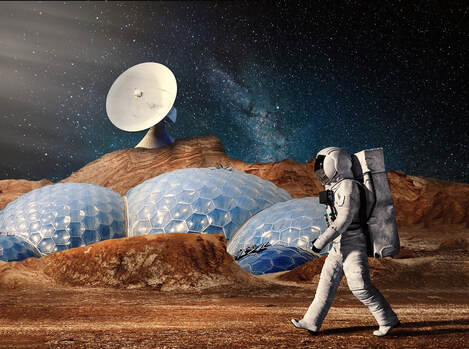 With international space agencies and the real-life Tony Stark (Elon Musk) making huge advances in rocket technology, it is likely that within the next couple of decades humankind will touch down on Mars. However, this is only half the battle. The gravity on Mars is roughly one third as strong as Earth’s. You may be thinking “great, everything will require less effort”, and you’d be right, however, there is a huge caveat to that. As we’ve found from the results of time spent in space (the longest continuous period being 14.4 months), when people are exposed to levels of gravity lower than that on Earth, losses in muscle and bone occur; predominantly, in muscles which we continually use to walk and maintain our posture. You may have heard the expression ‘use it or lose it’ - hugely applicable here. These losses can increase astronauts’ risk of injury when returning to Earth by leaving them very weak and fragile. A return mission to Mars will take around 3 YEARS to complete, mainly because of the wait for the two planets to be close enough in proximity again to allow a relatively short journey home. That’s around 12 months in microgravity and around 26 months in Martian gravity. Now, it doesn’t take a rocket scientist to figure out that, based on the numbers, the outlook for muscle retention isn’t great. That being said, we‘re still pretty uninformed about the extent to which living on Mars will stimulate our muscles. Mary UpritchardAdmin Director, InnovaSpace 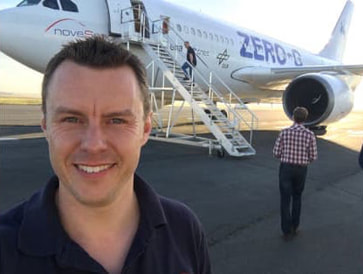 Prof. Nick Caplan, Northumbria University Prof. Nick Caplan, Northumbria University A really exciting week lies ahead for the Aerospace Medicine and Rehabilitation Laboratory team of researchers from Northumbria University in Newcastle, UK. Led by Professor Nick Caplan, the team will take part in a partial-gravity parabolic flight campaign organised by the European Space Agency, the problem under investigation being one that affects many astronauts when they spend time in the microgravity of space – back pain. It is well known that astronauts increase in height during their missions, usually between 3-5 cm. While under the influence of the gravity on Earth, the spine is compressed, rather like a spring being pushed down. Remove that force of gravity and the spring will expand and stretch, and this is what is thought to happen in space – the force of gravity is removed and so the vertebrae that make up the spine stretch out, and hence the increase in height and discomfort as connecting ligaments and support muscles extend. Over time spent in reduced gravity, research has demonstrated these muscles that connect the bones of the spine together shrink and weaken, particularly those in the lower back, as they are less required in space.
|
Welcometo the InnovaSpace Knowledge Station Categories
All
|
UK Office: 88 Tideslea Path, London, SE280LZ
Privacy Policy I Terms & Conditions
© 2024 InnovaSpace, All Rights Reserved
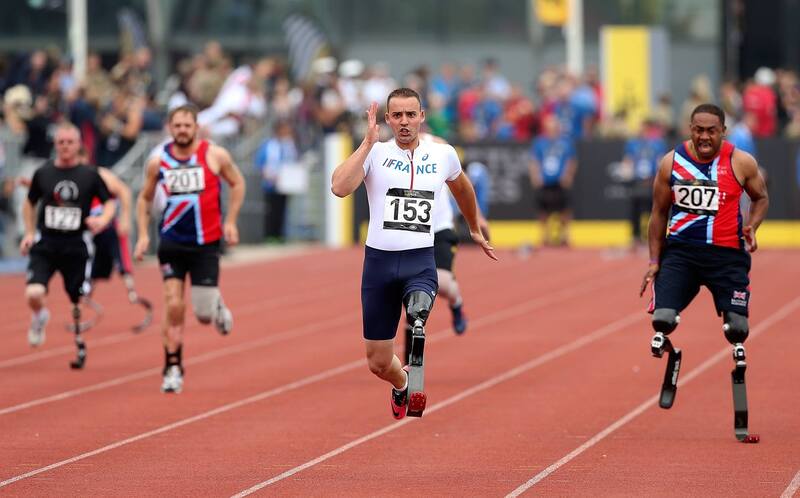

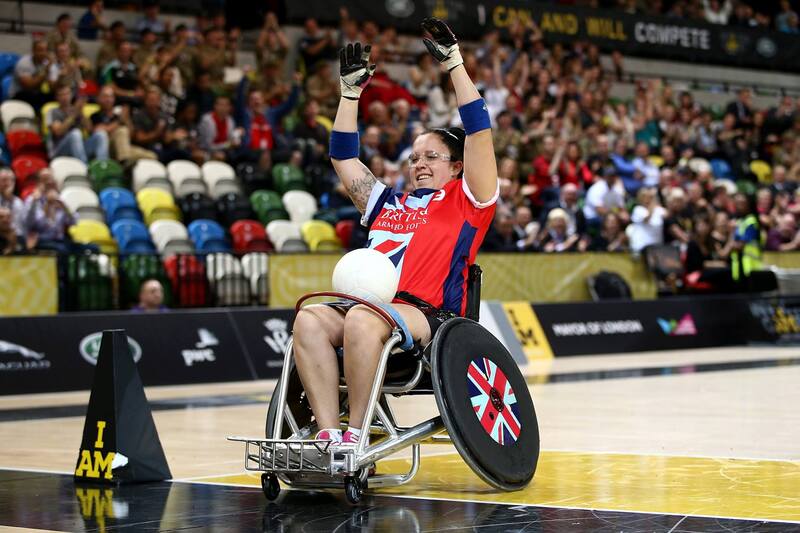
 RSS Feed
RSS Feed